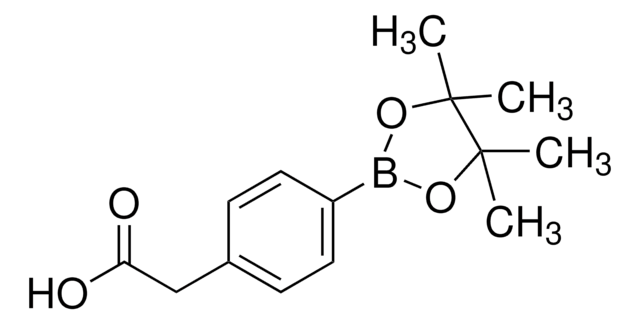The storage conditions that a Sigma-Aldrich catalog and label recommend for products are deliberately conservative. For many products, long-term storage at low temperatures will increase the time during which they are expected to remain in specification and therefore are labeled accordingly. Where short-term storage, shipping time frame, or exposure to conditions other than those recommended for long-term storage will not affect product quality, Sigma-Aldrich will ship at ambient temperature. The products sensitive to short-term exposure to conditions other than their recommended long-term storage are shipped on wet or dry ice. Ambient temperature shipping helps to control shipping costs for our customers. At any time, our customers can request wet- or dry-ice shipment, but the special handling is at customer expense if our product history indicates that the product is stable for regular shipment.
697095
2-Chloropyridine-3-boronic acid
Sinónimos:
(2-Chloro-3-pyridyl)boronic acid, (2-Chloropyridin-3-yl)boronic acid, Dihydroxy(2-chloro-3-pyridyl)borane
About This Item
Productos recomendados
Formulario
powder
mp
121-134 °C
grupo funcional
chloro
temp. de almacenamiento
2-8°C
cadena SMILES
OB(O)c1cccnc1Cl
InChI
1S/C5H5BClNO2/c7-5-4(6(9)10)2-1-3-8-5/h1-3,9-10H
Clave InChI
VRDAOVQZVXYRNH-UHFFFAOYSA-N
¿Está buscando productos similares? Visita Guía de comparación de productos
Aplicación
- Synthesis of Et canthinone-3-carboxylates from Et 4-bromo-6-methoxy-1,5-naphthyridine-3-carboxylate via a Pd-catalyzed Suzuki-Miyaura coupling and a Cu-catalyzed amidation reaction
- Preparation of arylmethylpyrrolidinylmethanols and amine derivatives via reaction with MIDA followed by Suzuki reaction with halides or amination with amines
- Preparation of arylazabicyclooctane derivatives as potential arginine vasopressin receptor antagonists
- Regioselective preparation of halo-oligopyridines and oligopyridines by the Suzuki-Miyaura cross-coupling reaction
Palabra de señalización
Warning
Frases de peligro
Consejos de prudencia
Clasificaciones de peligro
Eye Irrit. 2 - Skin Irrit. 2 - STOT SE 3
Órganos de actuación
Respiratory system
Código de clase de almacenamiento
11 - Combustible Solids
Clase de riesgo para el agua (WGK)
WGK 3
Punto de inflamabilidad (°F)
Not applicable
Punto de inflamabilidad (°C)
Not applicable
Equipo de protección personal
dust mask type N95 (US), Eyeshields, Gloves
Elija entre una de las versiones más recientes:
Certificados de análisis (COA)
¿No ve la versión correcta?
Si necesita una versión concreta, puede buscar un certificado específico por el número de lote.
¿Ya tiene este producto?
Encuentre la documentación para los productos que ha comprado recientemente en la Biblioteca de documentos.
-
How does the storage temperature relate to shipping conditions?
1 answer-
Helpful?
-
-
What is the pKa of Product 697095, 2-Chloropyridine-3-boronic acid?
1 answer-
The pKa of most boronic acids is approximately 9.
Helpful?
-
-
What compounds are formed when boronic acids degrade?
1 answer-
Boronic acids are typically very stable. However, if degradation occurs, Boronic acid will degrade to corresponding alcohol and boric acid.
Helpful?
-
-
What is the Department of Transportation shipping information for this product?
1 answer-
Transportation information can be found in Section 14 of the product's (M)SDS.To access the shipping information for this material, use the link on the product detail page for the product.
Helpful?
-
-
What is it about boronic acids that makes them acidic?
1 answer-
Boronic acids have a vacant p orbital. Therefore, despite the presence of two hydroxyl groups, the acidic character of most Boronic acids is that of a Lewis acid.
Helpful?
-
-
How can you determine if boronic acid anhydride is present? And if it is found to be present, how do you remove it?
1 answer-
Typically anhydride formation may be detected when the inside drying flask temperature increases abnormally, color change, or free flowing solid looks wet. To remove the anhydrides, charge de-oxygenated deionized (DI) water to the flask, and make slurry. Filter under nitrogen pressure, and use more de-oxygenated DI water for rinsing the solids. Then wash the solids with a solvent the product is insoluble in. Finally, dry the product with moist nitrogen.
Helpful?
-
-
What is the solubility for Product 697095, 2-Chloropyridine-3-boronic acid?
1 answer-
Unfortunately, we do not test the solubility for this product. However, a similar product (Product No. 634492) is soluble in THF at 25 mg/mL, and is very insoluble in DMSO.
Helpful?
-
Active Filters
Nuestro equipo de científicos tiene experiencia en todas las áreas de investigación: Ciencias de la vida, Ciencia de los materiales, Síntesis química, Cromatografía, Analítica y muchas otras.
Póngase en contacto con el Servicio técnico![[1,1′-Bis(diphenylphosphino)ferrocene]dichloropalladium(II)](/deepweb/assets/sigmaaldrich/product/structures/130/734/8846aa26-1858-458a-998d-8c306c13bf0f/640/8846aa26-1858-458a-998d-8c306c13bf0f.png)






![[1,1′-bis(difenilfosfino)ferroceno]dicloropaladio(II), complejo con diclorometano](/deepweb/assets/sigmaaldrich/product/structures/825/986/4317978b-1256-4c82-ab74-6a6a3ef948b1/640/4317978b-1256-4c82-ab74-6a6a3ef948b1.png)


